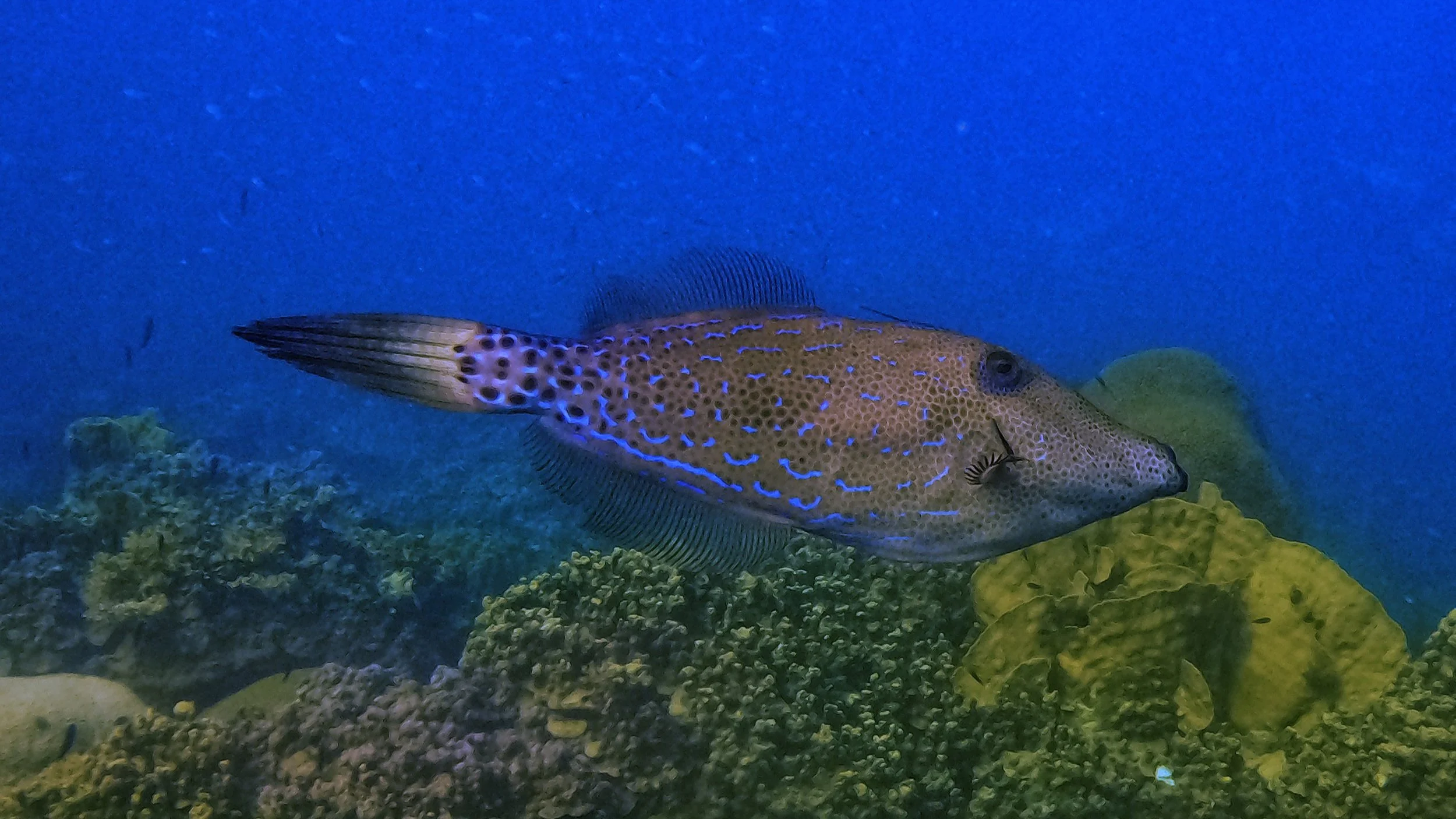Fish Files: Scrawled Filefish
The Scrawled Filefish (Aluterus scriptus), also known as the Scribbled Leatherjacket or Broomtail Filefish, is one of my favourite species to spot while scuba diving. My first encounter with this beautiful fish was in Koh Tao, Thailand, where I was immediately drawn to its vibrant colours, unique shape and intriguing behaviours. After that dive, I couldn’t wait to get back and look through the fish identification books to identify what kind of fish it was and learn more about it! Whenever I come across a Scrawled Filefish, I feel incredibly lucky and always take some time to admire it, as it’s not every dive you get the chance to see one.
Habitat
Scrawled Filefish inhabit the tropical and subtropical waters of the Atlantic, Pacific and Indian Oceans. They have been observed in lagoon and coral reef ecosystems, as well as on shipwrecks and in seagrass beds. While they are capable of swimming at depths of up to 100 metres, they are more commonly spotted in shallower waters ranging from 3 to 18 metres.
Appearance
As you can see in the photos, the Scrawled Filefish is easily recognised by its striking appearance, characterised by the randomly placed bright blue lines and black dots that cover its entire body. Underneath these patterns, the fish’s body colouration is predominantly olive-brown, although it can change its colour to better suit its environment.
This species has a flattened, diamond-shaped body that tapers at the front with a long snout and small, upturned mouth and at the back, with a broom-like tail (hence also being known as the ‘Broomtail Filefish’). Its dorsal, anal and pectoral fins appear almost translucent and play a key role in the fish’s movement through the water.
Instead of pelvic fins, the Scrawled Filefish has two dorsal spines, much like other fish in the Tetraodontiformes order. The first spine, located above the eye, can be raised into an erect position, where it is locked in place by the smaller second spine, which is only visible when the first spine is raised.
The fish has small, rough-textured scales, which likely inspired its common name, ‘Filefish’. When fully grown, they typically range between 50 to 90 cm in length, however, the largest Scrawled Filefish recorded was 110 cm!
Behaviours
When threatened, the Scrawled Filefish can raise its first dorsal spine and use it like a hook to wedge itself into small crevices and cracks, making it difficult for predators to pull it out. This mechanism is also used at night to protect the fish from predators and strong currents while sleeping.
Another defensive behaviour involves its ability to change its body colour to blend in with its surroundings. For instance, it can appear lighter against sandy backgrounds or darker in coral reef environments. With its random patterning and nearly translucent fins, the outline of its body becomes harder to detect, allowing it to disappear into its surroundings. In addition, the fish often swims in a vertical position (head down) near the ocean floor, mimicking the appearance of soft corals, like sea whips, or ocean vegetation, such as seagrass or seaweed, further confusing potential predators.
I thought I would also note that the Scrawled Filefish contains palytoxin, a poisonous marine substance found in its internal organs. This toxin can cause severe symptoms in humans, including death, making the fish unsafe to eat.
Diet
The Scrawled Filefish is omnivorous, meaning it feeds on both plants and animals. Although it is diurnal (active in the day and rests at night), it has been observed feeding both during the day and at night. Its diet primarily consists of algae, seagrass, gorgonian corals, anemones, hydrozoans and tunicates.
Reproduction
While the Scrawled Filefish is usually found alone or in pairs, it forms groups consisting of 1 male and 2-5 females during the breeding season. The females lay their eggs (oviparous) in protected, hollow areas on the ocean floor, where they are then fertilised by the male (external fertilisation). Both parents protect the eggs, but once they hatch, the female takes responsibility for caring for the young.
IUCN Red List Status
Least Concern (LC)
Taxonomy
Domain: Eukaryota
Kingdom: Animalia (Animals)
Phylum: Chordata (Chordates)
Class: Actinopterygii (Ray-finned Fish)
Order: Tetraodontiformes (Puffers, Triggerfish, Boxfish, Sunfish and Filefish)
Family: Monacanthidae (Filefishes)
Genus: Aluterus
Species: A. scriptus
References
iNaturalist (n.d.) Scrawled Filefish. Available at: https://www.inaturalist.org/taxa/49498-Aluterus-scriptus
National Marine Sanctuary Foundation (2020) Sea Wonder: Scrawled Filefish. Available at: https://marinesanctuary.org/blog/sea-wonder-scrawled-filefish
Sutton, A. (2017) Scrawled Filefish - Facts and Photographs. Available at: https://seaunseen.com/scrawled-filefish
Fishbase (n.d.) Aluterus scriptus. Available at: https://www.fishbase.se/summary/4275
Mazza, G. and Beltramini, M. (n.d.) Aluterus scriptus. Available at: https://www.monaconatureencyclopedia.com/aluterus-scriptus/


